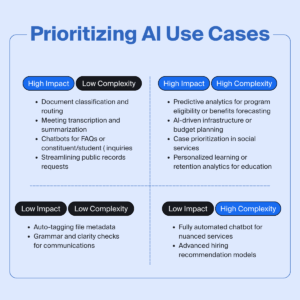
How to Build an AI Strategy in the Public Sector
AI can feel broad and overwhelming, especially for leaders in government and education who are balancing compliance, budgets, and service delivery. The greatest risk is doing nothing. Standing still may feel safe, but it leaves organizations vulnerable as technology and expectations evolve. The alternative isn’t…
Share this post:
AI can feel broad and overwhelming, especially for leaders in government and education who are balancing compliance, budgets, and service delivery. The greatest risk is doing nothing. Standing still may feel safe, but it leaves organizations vulnerable as technology and expectations evolve. The alternative isn’t rushing to buy the newest AI tool, but taking structured, deliberate steps. Think of it as start small, prove it out, then intelligently scale – building early wins and confidence before taking on larger, riskier projects. A clear strategy provides the structure to do just that, helping organizations turn broad ideas into specific steps that fit their mission and resources. In our playbook, we recommend four key phases that help agencies move from conversations about AI to a plan that is practical, measurable, and built to last.
1. Define Core Principles
Strategic: Agencies benefit from establishing guiding principles that set the tone for how AI will be used. These principles should be clear, easy to understand, and steady over time. They provide confidence that AI efforts will align with organizational values, build trust with citizens, and guide staff making day-to-day decisions.
Tactical: Once principles are defined, the focus should be on applying them consistently. Every project or proposal should include a discussion of how it supports those principles. One effective way is to create “user stories” that describe how a citizen or employee would experience the outcome. For example, if one principle is transparency, a user story could illustrate how a resident might easily see how an automated system reached its decision. This makes principles part of the culture rather than just a document.
2. Assess Current Readiness
Strategic: Before pursuing new initiatives, it is important to understand the organization’s starting point. Readiness spans areas such as data, governance, workforce skills, processes, and technology. Strengths and gaps in these areas determine how prepared an organization is to adopt AI.
Tactical: Leaders who want a structured way to begin can use the AI Readiness Scorecard to get an initial snapshot. This tool highlights areas where an agency is strong and where additional focus may be needed, giving leaders a baseline for planning next steps.
3. Prioritize Use Cases and Develop Policies
Strategic: Not every AI idea should move forward. Agencies should identify opportunities that provide meaningful value and can be delivered with available resources. At the same time, clear policies are needed to ensure use cases remain consistent with guiding principles.
Tactical: Use a value-versus-feasibility framework to evaluate options. Consider factors such as:
- Bandwidth: Do staff have the capacity to manage the project?
- Cost: Is the initiative financially realistic?
- Timing: Can it be delivered within the planning horizon?
- Difficulty: How challenging will it be to implement and maintain?
This process often brings forward practical opportunities such as:
- Virtual assistants to handle common citizen inquiries
- Predictive maintenance to reduce downtime and costs
- Automated reporting to improve compliance and free staff time
Alongside these, develop straightforward policies that reinforce principles. For example, a policy might state that staff must review outputs in sensitive cases, ensuring accountability stays clear.
Start by simply estimating whether a use case is likely to deliver high or low impact and whether realizing that impact would involve high or low complexity.
AI use cases rarely fit neatly into boxes. The examples in the grid below represent starting points — not absolutes. Depending on factors like your existing infrastructure, available data, technology stack, and staff skillsets, a single use case might land in a different spot for your organization. Think of this framework as a spectrum of impact and complexity, rather than four rigid quadrants.
And as AI capabilities continue to evolve, so will the grid itself. What’s high complexity today may become standard tomorrow. Revisiting this exercise regularly can help keep your priorities aligned with both your environment and the pace of innovation.

4. Turn Priorities Into Action
Strategic: Once use cases are prioritized, the next step is to move from planning to execution. This stage is about taking the groundwork — principles, readiness, and prioritization — and translating it into adoption. That requires responsibility, communication, and clear definitions of success.
Tactical: For each initiative, organizations should document:
- Ownership: Who is accountable for delivery and decision-making
- Communication: How updates, risks, and progress will be shared with leadership and staff
- Success criteria: The outcomes that will define whether the project has achieved its goals
- Adoption plan: Steps to ensure the solution is understood, trusted, and used effectively by staff or citizens
This approach ensures AI strategy is not just designed but implemented in a way that drives real results.
Moving Forward
A strong AI strategy balances caution with progress. By defining principles, assessing readiness, prioritizing use cases, and turning priorities into action, agencies can build momentum without overextending. The opportunity is to make steady, measurable progress while avoiding the extremes of paralysis or unchecked investment.
The best way to begin is with a clear picture of where you stand today. The AI Readiness Scorecard provides that baseline, helping leaders identify strengths, gaps, and the right next steps.
Last updated: October 3, 2025

Trusted by the Federal, State & Local Government agencies to implement dynamic and efficient people-centric solutions, Data Meaning provides business intelligence services to help Federal, State & Local government agencies drive analytical transformations and achieve better outcomes for constituents.
Data Meaning delivers specialized business intelligence and data analytics services designed for federal, state, and local government agencies. Trusted by national-level organizations, the company empowers public sector clients to drive analytical transformations and achieve better outcomes for constituents.
More Insight
Get updates on the digital frontier.


